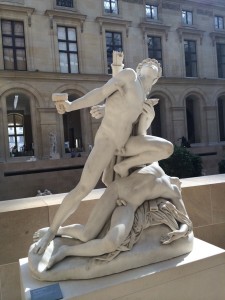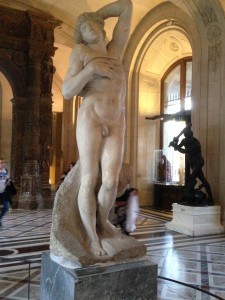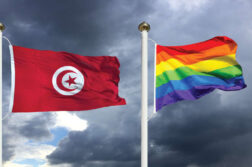I was in Paris just before the recent terrorist attacks, checking things out for Oscar Wilde Tours’ upcoming “Gay London/ Gay Paris” tour (August 20-28, 2016) and doing lots of the things that make Paris such a fantastic city—and also the target of attack by lunatics.

Among the many current diversions, there is a show about “Maison Closes” (bordellos) at the Bonheur de Vie gallery—a gallery every lover of gay history and art ought to know about, as it specializes in such objets as Wilhelm von Gloeden photos, Cocteau and Genet prints, and the like. The gallery is in old gay neighborhood (1950s-’70s) around the rue Sainte Anne. The nearby rue Chabanais has some wonderful sex history, as one of the great bordellos of the Belle Époque was at number 12. It was here that the British Crown Prince—the future Edward VII—kept his infamous sleigh-chair, which allowed him to have sex with the girls without crushing them, despite his enormous girth. You can actually see the chair these days at a huge and marvelous show at the Musée d’Orsay called Splendeurs et Misères (after the Balzac novel), which features courtesans of the 19th and early 20th century.
There are a number of great paintings in the show, and it teaches you to see the oblique references to prostitution in Impressionist work. There are also a lot of great objets, including ornate furniture from the palace of “La Paiva,” a famous 19th-century courtesan who ended up marrying two barons at different times, one Portuguese and one German, and building a great neoclassical mansion on the Champs Élysées, which is now the Travelers’ Club and generally closed to the public (except for the occasional Sunday morning; I went the last time we were in Paris).
There’s also a great show at the Musée de Luxembourg of sexy themes in a show called Fragonard Amoureux. This is a great deal of fun, and you can also add to your enjoyment by having pastry afterward at the new branch of the Café Angélina—Proust’s favorite—at the Museum. Proust’s preferred pastry was their Montblanc (a confection of meringue, chestnut cream vermicelli, and whipped cream), but they also have created, in the Parisian manner, a new pastry called the Vénus in honor of the show. Both are highly recommended, but only if you also have room for the hot chocolate, generally regarded as the best in Paris (i.e. the world)—so dense that it almost reduces one to tears.
In short, Paris is paradise, and always will be.

I also explored the Louvre, to see if I could put together a “Gay Secrets” tour on the model of my tours of the Met in New York and Boston’s MFA. Funny, some museums are great for LGBT art, others (e.g. the National Galleries, Washington and London) not so much. The Louvre falls on the affirmative side. To start with, it has not one but four statues of the Roman emperor Hadrian’s boyfriend Antinous, including a beautifully preserved, larger-than-life head from a cult statue (i.e. from a temple where he was worshiped as a god after his death). And then there’s all that great Greek art, with all those references to male-male love; a lot of Renaissance homoerotica, including the most languishing of the Michelangelo “prigioni”; and portraits of the several French kings about whom there are well-founded suspicions.
The most surprising things I found, though, were the homoerotic bits in 19th-century French art. I’ve always been skeptical about reading too much into the nude males in neoclassical paintings on Greek themes by artists like David, but I was surprised to find that it was all deliberate. In the gallery on the first floor with all the big patriotic French canvasses, there’s a huge painting by David titled Leonidas at Thermopylae, with the title figure brooding in the middle. But to my surprise, just off to Leonidas’ left, there’s a naked young man with flowers in his hair snuggling up to a bearded soldier, presumably his lover. This is exactly the kind of thing ancient Greek texts talk about, and it fits right into a neoclassical painting. Still, I never realized how explicitly aware painters like David were of the homoerotic side of the world they glorified.
I found another great example of this in the French sculpture court (the courtyard that’s lit up and visible as you walk through the Louvre at night): there’s a beautiful neoclassical sculpture called Nisus and Euryalus, the Greek-style male lovers from Virgil’s Aeneid. It’s an accurate depiction of Virgil’s story: Euryalus is dying on the ground, and Nisus is standing over him fighting off the enemy. But the great thing is that there’s no Classical antecedent for the statue. It’s not a copy. Instead, the 19th-century French sculptor Jean-Baptiste Roman was so moved by the story that he wanted to memorialize this great example of male-male love from Roman literature.
In short, the gay theme is all over the Louvre, As luck would have it, I’ll be giving a tour of the Louvre on the last morning of our “Gay London/Gay Paris” tour next August. Come to Paris and see for yourself what’s hidden in plain sight. Visit: www.OscarWildeTours.com.







Discussion1 Comment
Pingback: Gay History and Art in Paris-and the Louvre - Oscar Wilde Tours